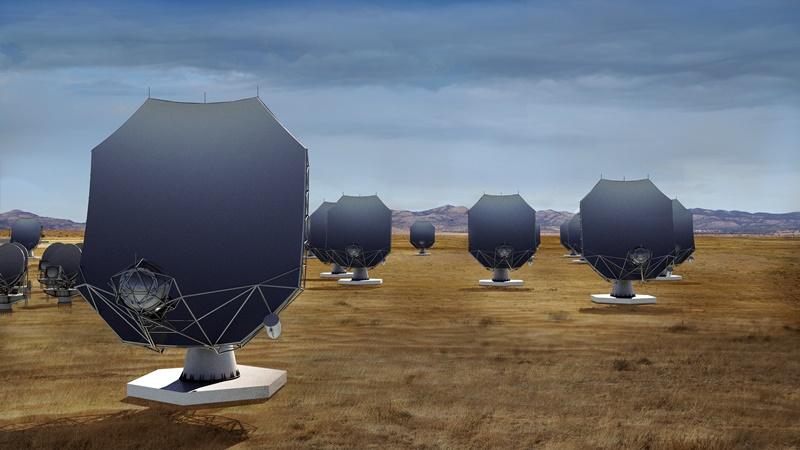
Artist’s conception of the mtex design for the ngVLA prototype antenna.
Sophia Dagnello | NRAO
The design for the Next Generation Very Large Array (ngVLA) prototype antenna has passed an intensive, five-day review, clearing the way to begin manufacturing the prototype antenna. The review in Wiesbaden, Germany was attended by scientists and engineers from the National Science Foundation (NSF), the NSF’s National Radio Astronomy Observatory (NRAO), and mtex antenna technology GmbH, the firm contracted to develop the design and produce the prototype. The NRAO and mtex representatives presented details of the design to a panel of experts — coming from U.S. and South African institutions — independent of the project.
The review panel’s report recommended that the project proceed to manufacturing the prototype antenna. They concluded that the design fulfills ngVLA requirements and is mature enough to be manufactured. While they noted some items that need additional work, they said those items are minor and do not require further external review. The panel also noted the “good, healthy, open and honest working relationship between mtex and NRAO.”
“The antennas are a key element of the ngVLA, and their performance is vital to the success of the entire system. I congratulate the NRAO-mtex team on this important milestone in their development,” said NRAO Director Tony Beasley.
The ngVLA, a powerful radio telescope with 263 dish antennas distributed across North America, is proposed as one of the next generation of cutting-edge astronomical observatories designed to meet the leading research challenges of the coming decades. It will have sensitivity to detect faint objects and resolving power more than 10 times greater than the current VLA.
NRAO and mtex signed a contract in mid-2021 for design of 244, 18-meter diameter antennas and production of a prototype. An additional 19, 6-meter antennas are not part of this contract. Based on NRAO specifications and a conceptual design study, NRAO and mtex have worked intensively to refine the design’s details to a level that allows prototype manufacturing to begin. The project is funded by the NSF.
The prototype will be manufactured by pre-selected suppliers and initially tested in 2023. In early 2024, it will be shipped to the VLA site in New Mexico. The prototype will undergo extensive testing before being integrated into the current VLA. After including any refinements arising from the final round of testing, the design will be ready for mass production, for which a separate contract will be awarded.
“This review confirmed that our colleagues at mtex clearly understand our needs for high quality and performance and also the requirement that the design can be manufactured cost effectively in the numbers needed,” said NRAO’s ngVLA Project Engineer Rob Selina.
In November of 2021, the ngVLA project received high priority from the Astronomy and Astrophysics Decadal Survey (Astro2020) of the U.S. National Academy of Sciences for new ground-based observatories to be constructed during the coming decade. That report said, “The ngVLA facility would be absolutely unique worldwide in both sensitivity and frequency coverage,” and added that its capabilities are “of essential importance to astronomy.” Earlier in 2021, the Canadian Astronomy Long Range Plan 2020-2030 recommended that Canada support the ngVLA.
Last month, NRAO and the Universidad Nacional Autónoma de México (UNAM) signed a memorandum of understanding establishing a collaboration on the ngVLA. The project will require approval by the NSF’s National Science Board and funding by Congress. Full construction could begin by 2025 with early scientific observations starting in 2028 and full scientific operations by 2035.
The ngVLA will have a dense core of antennas and a signal processing center at the current site of the VLA on the Plains of San Agustin in New Mexico. The system will include other antennas located throughout New Mexico and in west Texas, eastern Arizona, and northern Mexico. More far-flung antennas will be located in clusters in Hawaii, Washington, California, Iowa, West Virginia, New Hampshire, Puerto Rico (at Arecibo Observatory), the U.S. Virgin Islands and Canada. Operations will be conducted at the VLA site and in nearby Socorro, New Mexico, with additional science operations in a metropolitan area to be determined.
The National Radio Astronomy Observatory is a facility of the National Science Foundation, operated under cooperative agreement by Associated Universities, Inc.


















